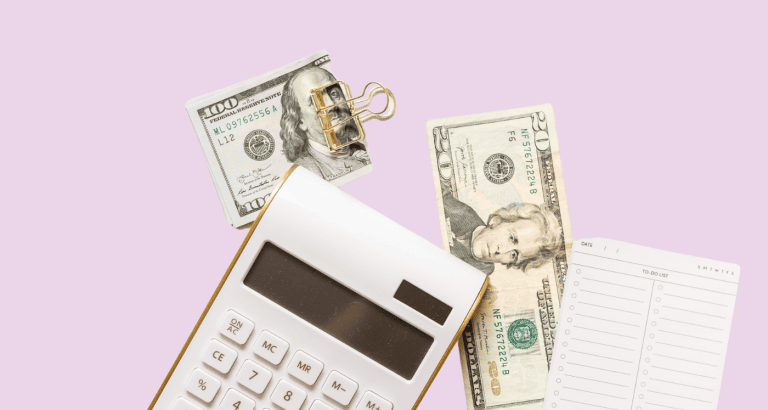Understanding the 60-20-20 Budgeting Rule

Budgeting is a helpful tool when you want to get your finances under control and save money.
In fact, budgets are good to have all the time. But when you start finding out more about them, you might discover that there are many different methods, making it challenging to decide which one to try.
As an affiliate partner of various brands and sponsored content, HerPaperRoute may earn commission on qualifying purchases. Disclaimer
It’s best to start with a few simple practices that allow you to start saving and spending appropriately right away.
The 60-20-20 budgeting rule is the perfect budget to start with, and you can modify it in some ways to fit your lifestyle better.
How the 60-20-20 Rule Works
This system is not difficult to understand, which is part of what makes it ideal for new budgeters or those that need to get back on track after overspending. The simplicity is the most attractive thing about this system.
60% to Expenses
When you get paid, take 60% of that income and use it to pay for your monthly expenses. Anything essential, such as housing costs, food, phone and internet payments, and other bills, will be part of this category.
Basically, anything you pay for on a consistent basis is considered an expense.
As far as debt payoff goes, there’s some debate about whether or not you should include it in this section. That means it comes down to your situation.
If your debts are minimal, and you’re paying them off monthly, I’d include it in your 60%. But if you are focusing on intense debt payoff, see the next section for advice.
20% to Savings
After you pay your monthly expenses, take the next 20% of your paycheck and put it towards savings. Savings can mean extra money for emergencies, retirement accounts, or other investments.
And suppose you are doing intense debt payoff. If this is the case, you can take a percentage of this money and apply it towards this, in addition to paying the minimums from the previous section.
That way, you can quickly get rid of your debt. Saving 20% also gives you a chance to save a significant amount without feeling like you never have money for anything else.
Below you’ll find some examples of what to save for:
- IRA – You can add money to your retirement IRA each month to make sure you’re maxing it out each year.
- 401(k) – If you work for an employer that offers a 401(k), add some of your savings money to this each month.
- Other Investments – In addition to your retirement accounts, you can also add money to different investments like mutual funds or shares of stock.
- Emergency Fund – Build up your emergency fund using your savings money. Your emergency fund will typically cover anywhere from 3-12 months of expenses, depending on your situation. I’d recommend focusing completely on this if you don’t yet have one set up.
20% to Spend
After you paid your bills and saved 20%, you’ll have 20% of your income left. And this is the fun part – you can spend it. On whatever you want!
Since you responsibly paid your expenses and saved for the future, any remaining money is yours to do what you like. Whether that’s coffee money, a new handbag, a weekend trip, or anything else.
You can spend guilt-free because you already took care of everything. Here are some ideas.
- A fun concert or a movie.
- Spend money on an experience such as cooking class or a gym membership.
- A flight to somewhere you’ve always wanted to visit.
- Spend on a pair of high-quality shoes.
- Tickets to a game or a show.
- Something new for your home or yard.
- A present for a friend or relative.
- A manicure or spa day.

How is the 60-30-10 budget rule different?
This is a slight variation of the 60-20-20 budgeting rule. Your expense category remains the same, but you’ll see some differences in the other categories.
30% to Savings Instead of 20%
This system is a bit stricter than the other one because you’ll save a little more. Instead of saving only 20%, you’ll instead save 30% of your income each month.
This is best for people who are trying to save a lot of money, have a high amount of debt to pay off, or have a larger income that makes it unnecessary to spend as large of a percentage.
What are the main differences?
- Stricter discretionary spending budget. This is the biggest thing, you’ll save more and spend less on non-essential items. You’ll still have some money to spend on whatever you’d like, just not as much.
- More savings. You’re going to be saving an extra 10% of your cash each month with this approach. That adds up to a lot more by the end of the year – hundreds or thousands of dollars more.
Balancing Your Financial Life with the 60-20-20 Budgeting Rule
If you want to give this simple and effective budgeting system a try, it isn’t difficult to begin. But you should consider these things so that the budget can fit effectively into your lifestyle, and you‘ll be able to keep up with it over time without spending extra hours on it.
Staying on Track
For the first few months or so, the 60-20-20 budgeting rule may feel like a struggle. That’s why it’s essential to employ whatever methods work for you to stay on track.
Find the things that help you stay motivated. Here are some ideas.
- Visual reminders – some people are motivated by visual reminders. You can use a vision board, a calendar, or whatever method helps you effectively stick to your budget.
- Reward system – If you like the idea of being rewarded for staying on track, try creating a strategy. You can make it part of your discretionary spending if you want.
For example, if you stick with your budget for a month, you might treat yourself to dinner out. After two months, maybe you do something a bit bigger, and so forth. Thinking of new rewards will help you to stay motivated over time.
- Daily check-ins – Check in with your budget each day. A few minutes, at most. If you simply glance at your budget each day for a moment, you can catch small mistakes and remind yourself of what you have left to spend and save.
Re-Evaluating After a Couple Months
After keeping up with the 60-20-20 budgeting rule for a couple of months, it’s time to see if it’s working out.
Ask yourself questions – was it challenging to stick to? Was it easy? Is there anything that needs to change to make it more effective?
At this point, you can tweak your budgeting categories if necessary, taking into account any new information you’ve learned.
Finding a Spending Method That Works
With this method, you’ll spend 20% of your income each month. But this can get a little confusing.
What do I mean? Well, if you pay your bills from the same account as you spend from, you might find yourself constantly checking to see what’s been paid and if you’re over budget in the spending category. There are much better ways.
Begin by taking out your spending money at the beginning of the month in cash. Many people like this approach because it’s easy.
It also works because the money is already out of your account, and it’s undeniable when you run out of money. Here’s how to start cash budgeting.
Another method is to place your spending money into a separate account entirely. Only spend from that account, and that way, you never mix up your expense paying money with your discretionary spending.
Balancing Your Financial Life
The first goal of budgeting is to effectively organize and manage your money. The second is to make your life easier.
You can consider your budgeting system effective when it runs smoothly, and you aren’t spending a ton of time each month keeping it running. You set it up to eventually run almost without help.
That way, you’re paying bills, saving for retirement, and spending without needing to devote a lot of brainpower or time to the system.
You’ll also want to find a way of budgeting that works well for you. Many people prefer apps now because you can create a budget anywhere at any time.
Spreadsheets or a notebook can also work if that’s better for you, as long as you’re organized about it. Keep good financial records if you ever need to go back and look at where your money went.
How to Get Started with the 60-20-20 Budgeting Rule?
This system is easily set up, and I’ll show you how to begin using this budgeting process immediately. That way, good financial results will happen as soon as possible.
Use a 60-20-20 Budget Rule Calculator
Keeping track of money can be difficult if you’re new to it or just don’t like numbers. You can simplify a lot by using a budgeting calculator. This can help you to keep track of your finances by doing the math for you.
This digital budget planner comes with a profit & loss tool that auto-calculates your financial health each month. This will let you know what amount you are spending in each budgeting category. You can easily add in amounts so that you get a complete picture of your finances.
Establish Routines of Pay Bills, Save, and Spend
Routines may seem like a lot at first, but they actually make life way easier. A routine will help you with your money.
Try to create habits for expense paying, bills, and spending. That means you sit down to do your budget at the same time each month, take a few moments to put your income in the correct accounts, and then consistently keep up with it.
Try this routine as you begin, starting on the 1st of the month or the day you get paid. If you get paid bi-weekly, you can budget twice a month, or you can do it once a month and account for all of your income at once.
- Check the amount in your bank account.
- Divide into the correct percentages – 60% for expenses, 20% for saving, and another 20% for spending.
- Place your 20% of savings into the correct places – IRAs, investment accounts, etc.
- Cash-out your 20% of spending money, or place it in a spending account.
- Put your expense money into the account you’ve chosen for bill paying. Pay off anything you can immediately, or set up automatic payments if you want to make things even easier.
- Take a little time to check in on your budgeting every week or month in case anything unexpected happens.
You can try this way of doing things if you want to get started without being too creative. Or you can build your own routine. Making a budget is all about finding what works for you, not following a set of rules. All that matters is that you do make one and that it makes sense to you.
Related: Benefits of Budgeting You Can’t Deny
The 60-20-20 Budgeting Rule Can Work for You
Even if you’ve tried other budgeting methods before with little success, the 60-20-20 budgeting rule can work for you. It’s one of the simplest ways to stay organized with your money, and it’s easy to begin using it right away.
Though it may take a little time to feel totally comfortable with it, you’ll soon learn to completely sync your lifestyle to this budget.
And if you feel like you want to save more or this budget isn’t quite strict enough, you can try the 60-30-10 variation. It will help you save even more and pay off debt incredibly quickly while still allowing you to spend some money and not feel like you’re missing out on anything.
Give the 60-20-20 budgeting rule a try, or the 60-30-10 rule, if you prefer. Either of these budgeting options can help you to handle your expenses and save for the future.
You can also enjoy your life by continuing to spend a percentage of your paycheck without guilt. Keep checking in with your budget, don’t give up, and you will soon see success, a higher savings rate, and more control of your financial situation than ever before.
Related Articles:

Follow along on Instagram!










